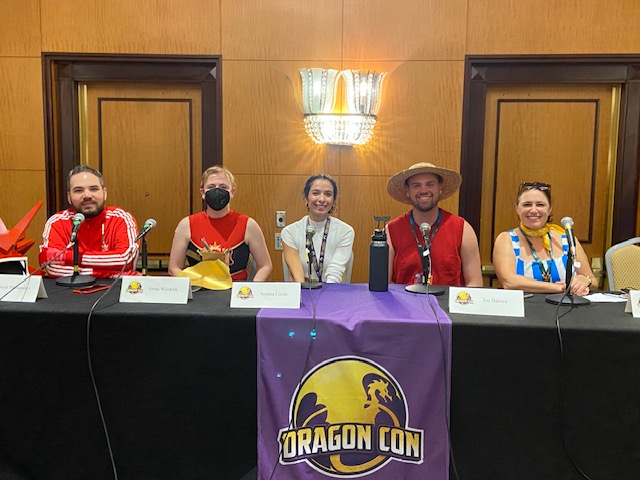
At the “The Benefits of Being a Marine Biologist Beyond Growling at Shark Week” panel from the Science Track in the Hilton Crystal Ballroom on Friday at 4PM, Jamie Bernstein served as the panel moderator, with speakers Sophia Corde, Joe Hansen, Lucas Hernandez, and Arras Wiedorn, all of whom are marine biologists or work with animals in some capacity.
Bernstein began the panel by asking the panelists to define marine biology. She noted that a lot of kids want to be marine biologists, but in reality few people know what marine biologists actually do. In doing her research, it seemed very difficult to pinpoint. For example, are seabirds a part of marine biology? What about freshwater animals?
The panelists agreed that marine biology is a very broad field despite having a more specific definition. Short Answer: seabirds yes, freshwater fish no. But freshwater has impacts upon marine biology where rivers empty as estuaries into the ocean.
Bernstein then asked the panelists what was something about their careers they didn’t expect? The most common answer: Stats. Programming.
While marine biologists typically get into the field because they like animals and want to work with animals, they actually interact with animals for very short periods of time to collect data. They spend the rest of that time in an office or lab running that data through computer models to obtain answers for their research.
Another reality for scientists is that those times when they are working with animals, a lot of the work can actually be tedious. Wiedorn shared that for each particular science project in the field, a marine biologist is often going to the same areas day after day, following the same paths, studying the same animals, and recording the data. Occasionally something cool will happen, but that’s not the norm.
For Hansen, when he worked on his master’s degree, he spent a whole summer in boats out on the water. He studies microbials on dolphins and gets samples to study dolphin health. Cool at first, but he did it for 12 hours per day, seven days per week, for the entire summer. And when they got off the boat, they often had to do more hours of filtering water from the samples they collected.
Corde studies human/manatee interactions. She has swum with manatees on a few occasions, but noted they were actually terrifying experiences instead of thrilling. Manatees are huge, they live in same areas where alligators live, and that’s in swampy water where you can’t see the manatees or the alligators.
Bernstein then asked the panelists their favorite and least favorite parts of their jobs.
For Hernandez, who works in the South Carolina Aquarium in Charleston, SC, he loves to educate the diverse audiences they see at aquariums. Every day they see a random assortment of people from all walks of life, and he gets to share a little bit of the natural world with them.
The worst part of his job is dealing with people who don’t want to listen. People who want to interact with the animals (ie, pet them) despite warnings not to do so. Hernandez can put up signs to warn people, but many people don’t bother to read them. Or ignore them.
The most incidents according to Hernandez: people getting bit by trout. You stick something close to their mouth and they will bite. They like to eat whatever they can get their mouths on.
Hernandez added that most people think his job is handling animals all the time, like he has all these wild pets. He handles animals some, but interactions are very limited. The aquarium is their home and they’re supposed to be comfortable.
Arras added that their job in an aquarium or zoo is to give the animals choice and control. If the animal’s mindset that day is “I hate you, leave me alone,” then that’s what workers do.
The moderator then asked the panelists how they conducted their research in foreign locations.
Corde had to get an international permit for her master’s degree work. She spent three years getting her degree and it took three years to receive the permits. She ended up having to get added to someone else’s permit to conduct her research. She worked in Kenya helping local farmers build fences to deter elephants, and they collaborated with the farmers to determine what would work best with the elephants.
When they opened up the panel to audience questions, one person asked what the panelists thought about ecotourism. Wiedorn noted that there are a lot of people who think animals should always be left in the wild, not be placed in zoos. However, studies show the more people learn and see animals, the more they care about those animals. And those interactions are safer in zoos. People want to pet wild animals when they don’t want to be petted. The locks at zoos aren’t to keep the animals in; it’s to keep the people out.
Another reality, when people wander through nature in an ecotourism manner, they end up trashing the area, causing more pollution.
Hansen noted that in Alabama down on the gulf, there are tour groups that take people out in boats to see dolphins. The boats create a wake and the operators will use two boats to trap the dolphins between two wakes and forced the dolphins to jump over them. It creates great photo opportunities for tourists, so the companies get great reviews. Reality is they are harassing and stressing the dolphins.
Wild animals also often have difficulty distinguishing between animals. If you feed a wild animal and they get comfortable with you, they think all humans are nice. That’s not always the case. It’s better to leave wild animals alone.
